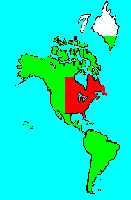SPECIES INFO
Snailseed (Cocculus carolinus) is found from Virginia west into Illinois and Kansas and south into Florida and Texas. This vine is primarily found along streams. The leaves can be heart shaped or lobed.Cocculus genus contains 11 species of climbing vines, shrubs, and small trees. The genus can be found in Asia, Africa, and North America. There are three species now growing in North America.
Moonseed family (Menispermaceae) is found from eastern North America south through most of eastern Central America and South America except the dry areas of Brazil south of the Amazon. In the Old World this family is found from Central Africa east to India and the Orient and south to Malaysia, Indonesia, and Australia.
This family has about 525 species organized into about 78 genera. There are eight species organized into five genera found in the greater North American area, including Hawaii and Puerto Rico and the Virgin Islands. Most of the members of this family are tropical and sub-tropical vines (with a few trees and herbs). The mostly entire leaves are alternate and mostly palmately veined with petioles. The flowers are usually tiny.
Ranales Order has been broken down into nineteen different families. The water lilies, buttercups, magnolias, and other groups are included in this order. Large pretty flowers seem to be a common characteristic of this order.
The families in this order are in the process of a major re-location. The water lily family (Nymphaeaceae) appears to be an ancient family of plants, and its proper place is open to question. The hornwort (Ceratophyllaceae) family also appears to be a very ancient family, and probably does not belong here either.
Furthermore, the magnolia family (Magnoliaceae) and the buttercup family (Ranunculaceae)are not as closely related to each other as previously presumed, and that is an incentive to further dividing this order.
Until this organization is finalized, we are temporarily retaining this older order.
Dicots (Dicotyledoneae Class) are the predominant group of vascular plants on earth. With the exception of the grasses (Monocots) and the Conifers (Gymnosperms), most of the larger plants that one encounters are Dicots. Dicots are characterized by having a seed with two outer shell coverings.
Some of the more primitive Dicots are the typical hardwood trees (oaks, birches, hickories, etc). The more advanced Dicots include many of the Composite (Aster) Family flowers like the Dandelion, Aster, Thistles, and Sunflowers. Although many Monocots reach a very high degree of specialization, most botanists feel that the Dicots represent the most advanced group of plants.
Seed plants (Phylum Embryophyta) are generally grouped into one large phylum containing three major classes: the Gymnosperms, the Monocots, and the Dicots. (Some scientists separate the Gymnosperms into a separate phylum and refer to the remaining plants as flowering plants or Angiospermae.)
For North American counts of the number of species in each genus and family, the primary reference has been John T. Kartesz, author of A Synonymized Checklist of the Vascular Flora of the United States, Canada, and Greenland (1994). The geographical scope of his lists include, as part of greater North America, Hawaii, Alaska, Greenland, Puerto Rico, and the Virgin Islands.
Kartesz lists 21,757 species of vascular plants comprising the ferns, gymnosperms and flowering plants as being found in greater North America (including Alaska, Hawaii, Greenland, Puerto Rico and the Virgin Islands.
There are estimates within the scientific world that about half of the listed North American seed plants were originally native with the balance being comprised of Eurasian and tropical plants that have become established.
Plant kingdom contains a large variety of different organisms including mosses, ferns, and seed plants. Most plants manufacture their energy from sunlight and water. Identification of many species is difficult in that most individual plants have characteristics that have variables based on soil moisture, soil chemistry, and sunlight.
Because of the difficulty in learning and identifying different plant groups, specialists have emerged that study only a limited group of plants. These specialists revise the taxonomy and give us detailed descriptions and ranges of the various species. Their results are published in technical journals and written with highly specialized words that apply to a specific group.
On the other hand, there are the nature publishers. These people and companies undertake the challenging task of trying to provide easy to use pictures and descriptions to identify those species.


